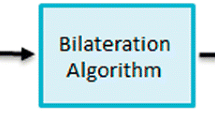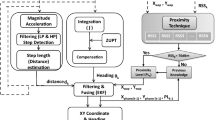Abstract
As interests and demands for indoor positioning have recently increased, a positioning scheme utilizing the smartphone equipped with various sensors like an acceleration sensor and a geomagnetic sensor has been expected as a high potential and practical candidate for indoor positioning purpose. The acceleration sensor and the geomagnetic sensor are used for the estimation of travelled distance and the direction of movement of pedestrians, respectively. Although it provides very accurate positioning performance, the positioning scheme based only sensors tends to be affected by indoor environments like magnetic field of general indoor office building. In addition, the positioning error is apt to be accumulated as the travelled distance is increased. In this paper, therefore, a new positioning scheme is proposed to compensate the conventional positioning technology and to enhance the positioning performance. The proposed scheme consists with positioning based sensors, multi-lateration and WLAN-ID based on received signal strength (RSS) of Wi-Fi signals. The proposed scheme is evaluated with experiments at general building in university and the performance of the proposed scheme is superior to the conventional schemes such as a positioning scheme with only sensors and a positioning scheme based on RSS of Wi-Fi signals only.



Similar content being viewed by others
References
Bahl, P., & Padmanabhan, V. N. (Eds.) (2000) RADAR: An in-building RF-based user location and tracking system. IEEE INFOCOM, pp. 775–784.
Hashim, R., Ikhmatiar, M., Karmin, M., & Herawan, T. (2011). Mosque tracking on mobile GPS and prayer times synchronization for unfamiliar area. International Journal of Future Generation Communication and Networking, 4(2), 37–48.
Patwari, N., Ash, J., Kyperountas, S., Hero, A. O., I. I. I., Moses, R., & Correal, N. (2005). Locating the nodes: Cooperative localization in wireless sensor networks. IEEE Signal Processing Magazine, 22(4), 54–69.
Gomez, J., Tayebi, A., del Corte, A., Gutierrez, O., Gomez, J. M., & Saez de Adana, F. (2013). A comparative study of localization methods in indoor environment. Wireless Personal Communications, 72(4), 2931–2944.
Gustafsson, F., & Gunnarsson, F. (2005). Mobile positioning using wireless networks: Possibilities and fundamental limitations based on available wireless network measurements. IEEE Signal Processing Magazine, 22(4), 41–53.
Chang, N., Rashidzadeh, R., & Ahmadi, M. (2010). Robust indoor positioning using differential Wi-Fi access points. IEEE Transactions on Consumer Electronics, 56(3), 1860–1867.
Jain, V. K., Tapaswi, S., & Shukla, A. (2011). Location estimation based on semi-supervised locally linear embedding (SSLLE) approach for indoor wireless networks. Wireless Personal Communications,. doi:10.1007/s11277-011-0416-2.
Mitilineos, S. A. (2011). Blind position location via geometric loci construction. Wireless Personal Communications,. doi:10.1077/s11277-010-9966-y.
Alam, M. S., Alsharif, S., & Haq, N. (2011). Efficient CDMA wireless position location system using TDOA method. International Journal of Communication Systems, 24(9), 1230–1242.
Jeon, H., Jo, U., Jo, M., Kim, N., & Kim, Y. (2013). An adaptive AP selection scheme based on RSS for enhancing positioning accuracy. Wireless Personal Communications, 69(4), 1535–1550.
Yun, K., Jo, Y., Kim, N., Jo, U., & Kim Y. (2012). A simple indoor positioning scheme with acceleration and geomagnetic sensors. In International conference on computer and applications (CCA 2012).
Jianwu, Z., & Lu, Z. (2009). Research on distance measurement based on RSSI of Zigbee. International Colloquium on Computing, Communication, Control, and Management ISECS, 2009, 210–212.
Rappaport, T. S. (2002). Wireless communications: Principles and practice. Upper Saddle River, NJ: Prentice Hall.
Willaredt, J. (2011). WiFi and cell-ID based positioning-protocols, standards and solutions. SNET Project WT, 2011.
Trevisani, E., & Vitaletti, A. (2004). Cell-id location technique, limits and benefits: An experimental study. In Mobile computing systems and applications, 2004. WMCSA 2004. Sixth IEEE workshop on, 2004, pp. 51–60.
Acknowledgments
The present research has been conducted by the research Grant of Kwangwoon University in 2015. This research was supported by the Basic Science Research Program through the National Research Foundation of Korea (NRF), funded by the Ministry of Education (NRF-2013R1A1A2005157).
Author information
Authors and Affiliations
Corresponding author
Rights and permissions
About this article
Cite this article
Kim, N., Jo, U., Yun, K. et al. A Hybrid Positioning Scheme Exploiting Sensors and RSS of Wi-Fi Signals. Wireless Pers Commun 85, 1111–1121 (2015). https://doi.org/10.1007/s11277-015-2829-9
Published:
Issue Date:
DOI: https://doi.org/10.1007/s11277-015-2829-9




